An Introduction to eSIM and Device Entitlements
What is eSIM?
Welcome to this introduction to eSIM. In this video we'll be looking at what eSIM is, the benefits of eSIM, and also its market adoption.
So let's start with what is eSIM. The best way to understand what eSIM is is to look at the SIM card itself. Why do we have a SIM card today? Essentially it has to do with the mobile network operator determining who is using the device so that they can be charged for the various services they are using on the mobile network.
The mobile operator distributes this SIM card to the customer who owns the device. The customer can either get the SIM card from a retail store or maybe they have one delivered to them.
The SIM card is actually a mini-computer. It's got memory. It's got a processor and it runs applications. Most importantly it has some secret information that's stored on it by the operator.
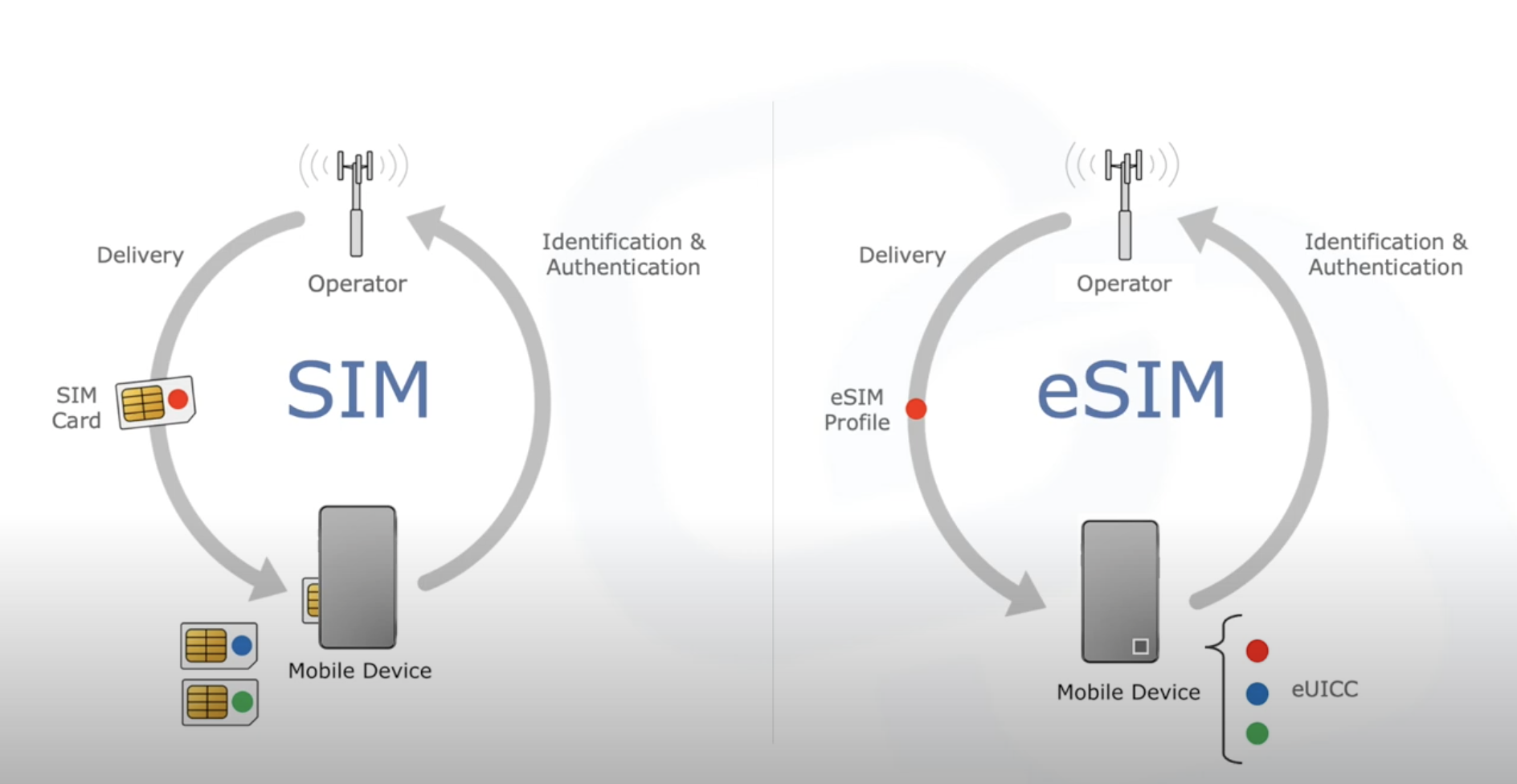 The red dot on the SIM card signifies that the data on the card relates to a particular operator. Other colors signify data relating to other operators.
The red dot on the SIM card signifies that the data on the card relates to a particular operator. Other colors signify data relating to other operators.
When the SIM card is inserted into the mobile device it is used to identify and then authenticate the customer to the operator's network, allowing the customer to be charged for the services used.
Now the customer might have more than one SIM card but of course the mobile device can generally only take one SIM card at a time, so the other SIM cards would probably be held in the customer's wallet or purse.
Moving on to eSIM then, the only technical difference is that the SIM card itself is no longer present but the data that was on the card, again, signified as a colored dot, is downloaded over the internet onto the customer's device directly.
We call this data an eSIM Profile. When an eSIM Profile is received in the mobile device it has to be stored somewhere. Now we cannot use the conventional memory of the mobile device to do this because it's not secure enough and could be hacked so instead there is a special eSIM chip soldered into the device called an eUICC to store this data securely.
Now you can see that we actually have three eSIM Profiles stored in this eUICC from three different operators – red, blue, and green. The eUICC can actually store any number of eSIM Profiles, limited only by its memory and typically one of those Profiles will be marked as active.
The active Profile in the eUICC operates in exactly the same way as a physical SIM card being used to first identify, then authenticate the customer to a particular operator's network.
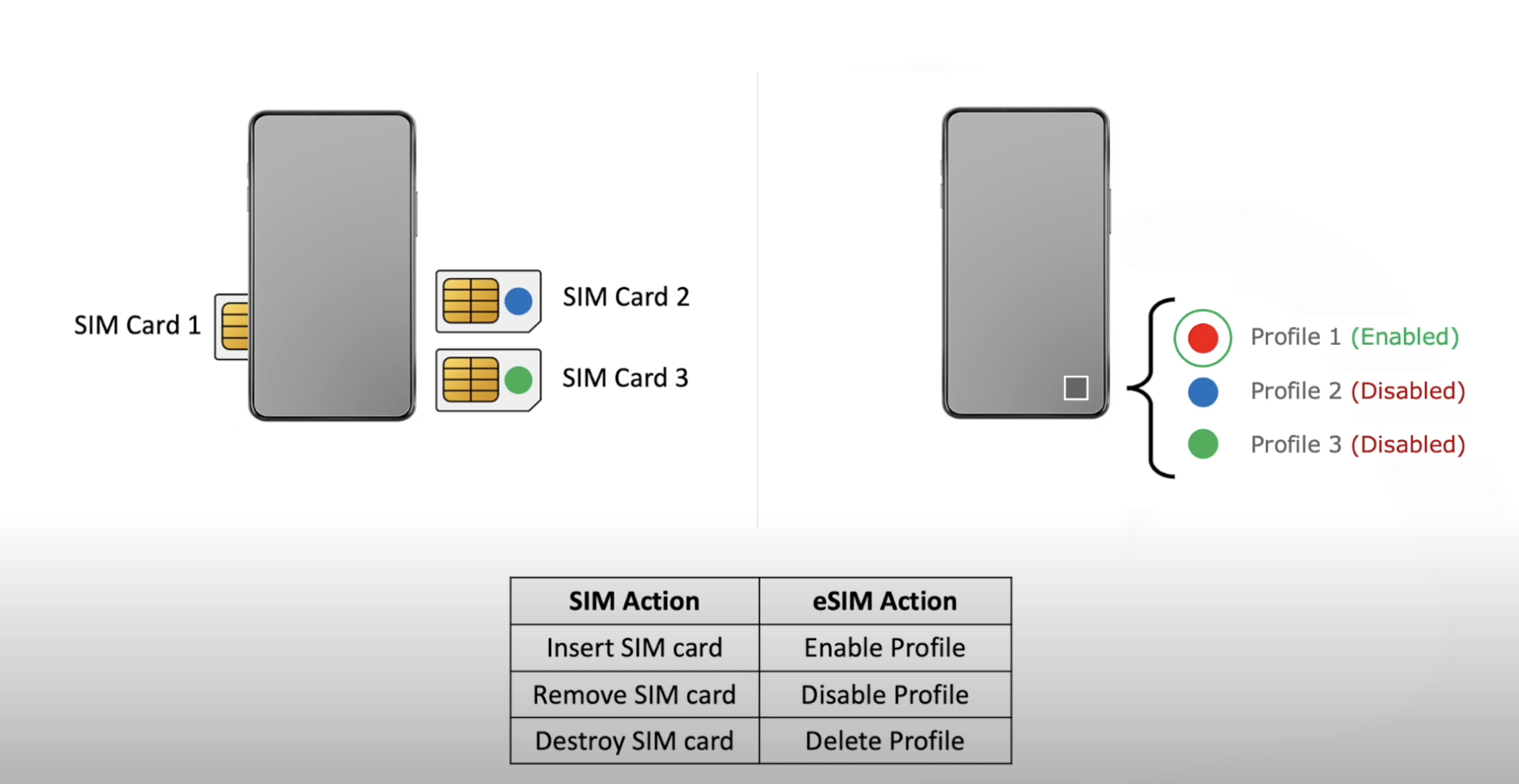 It's worth at this point having a quick look at the differences between physical SIM cards and eSIM Profiles in terms of how the customer interacts with them. For physical SIM cards there are three main actions: inserting a SIM card into the device, removing a SIM card from the device, and then eventually destroying the SIM card once it's finished with, typically by cutting it in half using a pair of scissors.
It's worth at this point having a quick look at the differences between physical SIM cards and eSIM Profiles in terms of how the customer interacts with them. For physical SIM cards there are three main actions: inserting a SIM card into the device, removing a SIM card from the device, and then eventually destroying the SIM card once it's finished with, typically by cutting it in half using a pair of scissors.
Now we can look at the corresponding actions with eSIM Profiles. Enabling an eSIM Profile is the same action as inserting a SIM card, and you can see here in the diagram that Profile 1 is currently enabled meaning it is active. Disabling a Profile is the same as removing the SIM card making it inactive and deleting a Profile removes it from the eUICC freeing up space for other eSIM Profiles to be downloaded.
The Benefits of eSIM in Consumer
Let's now have a look at the main benefits of eSIM and we split these benefits across two main markets: Consumer and IoT (internet of things). We'll talk about the benefits for IoT shortly but first let's cover the consumer market, and a good place to start here is to talk about device activation.
If you want to connect your consumer device to a network you'll need a SIM card, and there are typically two ways to get a hold of one. You can travel out to a retail shop or you can wait for one to arrive in the post. And of course when the SIM card does arrive you'll need to make sure it's the right size SIM for the device you have given that there are three sizes of SIM card available today - the mini SIM (which has been around for about 20 years), the micro SIM (which was popular about 5 to 10 years ago), and the nano SIM (which is now the most popular size today).
Moving over to the eSIM world things are far simpler. We don't need to worry about physical SIM cards anymore. All we do now is download an eSIM Profile into the device and we're connected… and there are a number of ways to do this.
We can scan a QR code with the device we want to connect to start the download, or we can download a mobile app and then select and pay for the data plan we'd like. The app will then take care of the download and installation of the eSIM Profile in a seamless way.
There are other activation methods too including service discovery and entitlements which we'll cover later.
So with eSIM there is no need to go to a retail outlet anymore and there's no need to wait for something to arrive in the post. Furthermore, there is no need to worry about having the right size of SIM especially when transferring between devices.
For the devices themselves, of course, there is a SIM tray in the device for the SIM card but this is effectively a hole inside the device making it more difficult for that device to become waterproof. And of course, when the SIM card is not inserted into the device it is easily lost.
Then if we were to look inside the device the space taken up by the SIM tray is quite large relative to other components. It's almost the same size as the main processor and that is space that could be used by the device manufacturer for other things in the eSIM world there is no SIM tray requirement anymore, and this allows for much smaller devices to be manufactured.
Devices like smartwatches, fitness bands, or even smart identity badges. It'll be interesting to see what new device categories appear as time goes on and given the absence of any SIM tray, devices can now be made more waterproof and the space now freed up inside the device can be used for other things including new functionality or even a larger battery.
Looking at the logistics of handling SIM cards… well actually for the operator is quite expensive. They order millions of SIM cards every year which typically get delivered to a warehouse in the operator's country of operation, and then from there those SIM cards are packaged and distributed to thousands of retail outlets. The logistics of this are expensive and quite problematic for the operators, especially with changes in form factor and progressive network technologies (for example 4G to 5G) requiring different data to be loaded onto the SIM cards.
In the eSIM world it's very different. The eSIM Profiles are generated then stored on a central backend server called an SM-DP+ which is managed by the network operator. Then, as required, these Profiles are delivered by the SM-DP+ to any mobile device anywhere in the country of operation or even worldwide for the larger operators.
And then there is an environmental saving because at the moment six billion SIM cards are produced and eventually discarded every year. When eSIM becomes mainstream all of that waste disappears.
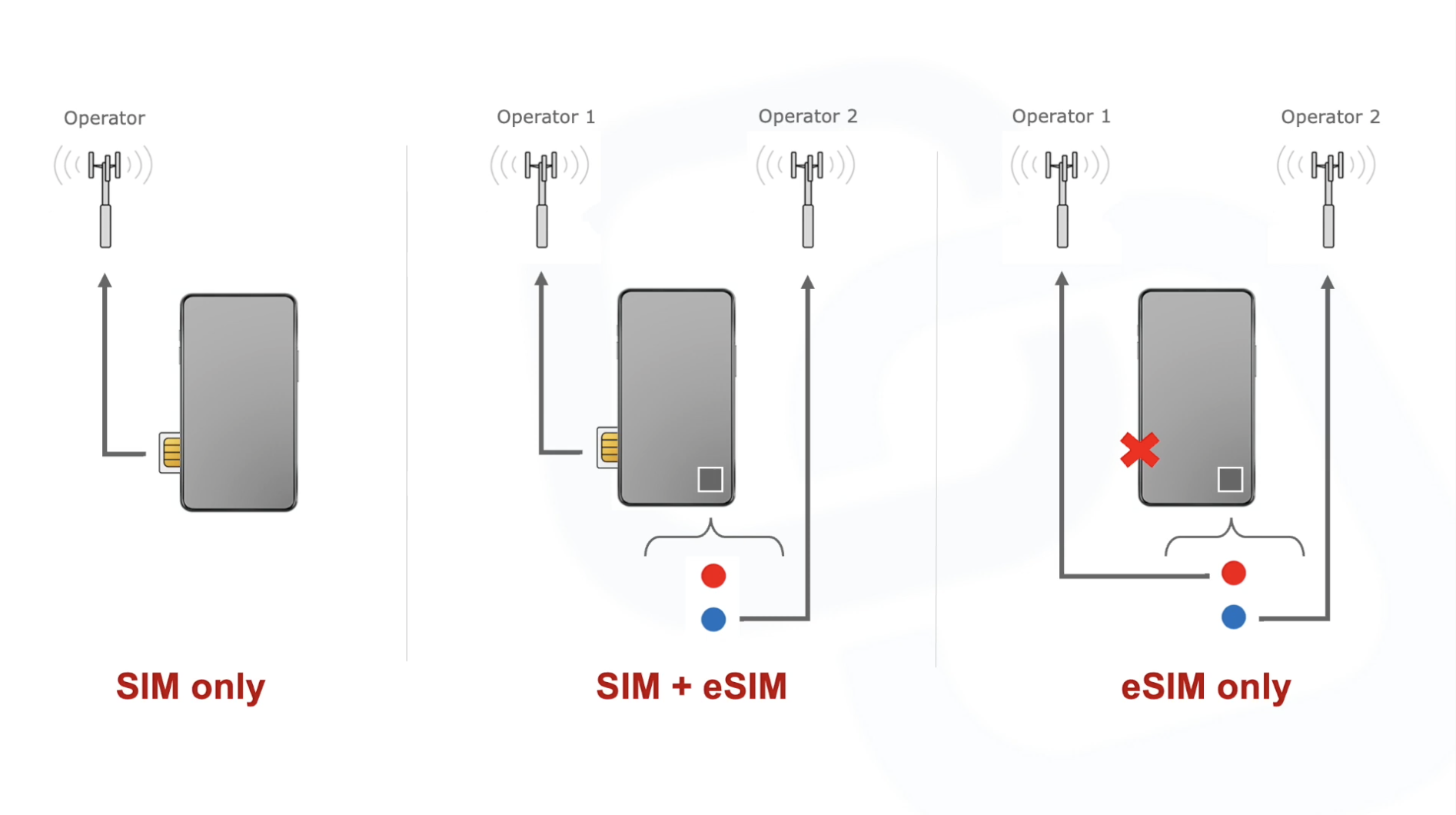 There is an additional benefit of eSIM in consumer devices, particularly smartphones, a new feature called dual-SIM-dual-standby or DSDS. Prior to eSIM, most devices only had a single SIM tray allowing it to be connected to a single network. With the advent of eSIM and device manufacturers knowing that operators in some countries will take time before they are eSIM-ready, eSIM-enabled smartphones will still include a SIM tray in order that these devices can still sell into those countries.
There is an additional benefit of eSIM in consumer devices, particularly smartphones, a new feature called dual-SIM-dual-standby or DSDS. Prior to eSIM, most devices only had a single SIM tray allowing it to be connected to a single network. With the advent of eSIM and device manufacturers knowing that operators in some countries will take time before they are eSIM-ready, eSIM-enabled smartphones will still include a SIM tray in order that these devices can still sell into those countries.
It is the existence of both eSIM and a SIM tray in the device that allows for the device to be connected to two networks at the same time. This brings about many new use cases for the consumer, including separation of business and personal subscriptions on the one mobile device, and low-cost local data - via a travel subscription - while still receiving calls on their main number when on vacation, or business abroad.
As more and more operators around the world support eSIM the SIM tray will disappear from devices, but it will still be possible to have two network connections at the same time using two eSIM Profiles.
The Benefits of eSIM in IoT
Let's have a look now at some of the benefits of eSIM in the IoT market. What you see here is a typical wireless module that would be installed in a whole variety of IoT devices, including utility meters, shipping containers, vending machines and medical equipment and so on.
Circled in red you can see the connector where a physical SIM card would be attached, allowing the wireless module to connect to a mobile network. This connector has some spring-loaded contacts which make contact with the electrical plate of the SIM card when inserted. This allows the device to communicate with the SIM in order to get the device onto a mobile network.
The problem is that in some IoT environments, for example in agriculture, the device will endure a great deal of vibration and instances of shock. This can cause the spring-loaded contacts to disconnect from the SIM card momentarily causing problems with the device even if there is no vibration. These spring contacts can deteriorate through microscopic electrical arcing over many years of operation.
And just with consumer devices because there is a hole in the module in order to insert the SIM card, this can result in humidity and corrosion. For example, in the case of an IoT water meter at a reservoir.
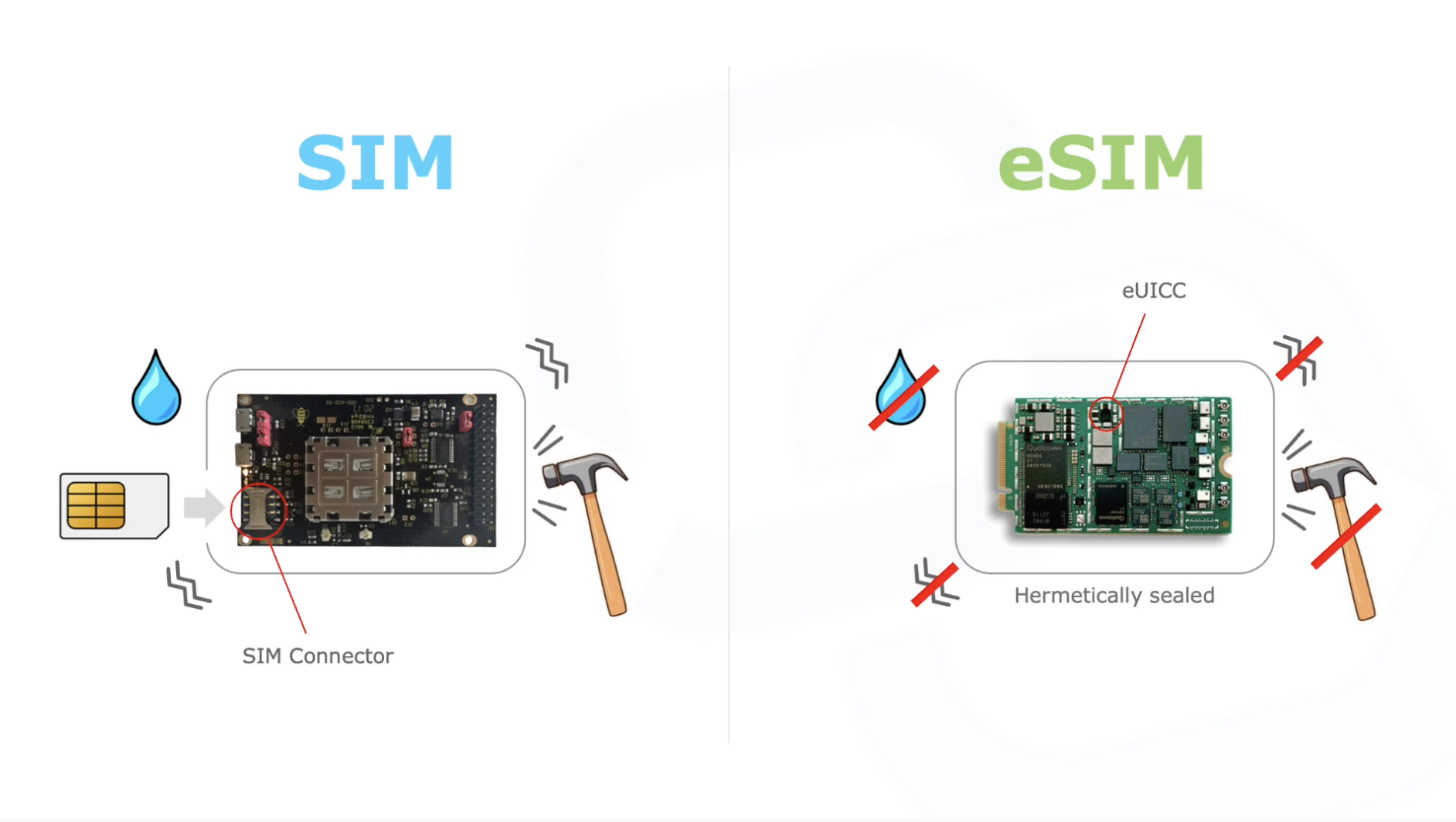 In the eSIM world things are very different. The eUICC is soldered into the device at manufacture and because of that the device can be hermetically sealed. That way we avoid any vibration and shock issues, and we avoid any problems with humidity.
In the eSIM world things are very different. The eUICC is soldered into the device at manufacture and because of that the device can be hermetically sealed. That way we avoid any vibration and shock issues, and we avoid any problems with humidity.
Let's now look at the production of IoT devices, and for the example here we're using the production line at a car manufacturing plant. Today with physical SIM cards there has to be a stock of SIM cards for each of the countries that the cars will be shipped to and at some point on the production line the correct SIM cards will have to be fitted into the right cars. This is logistically complex for the car manufacturer.
With eSIM though the situation has improved greatly. All of the cars will already have an eUICC built-in, and this will be the same part number for each car no matter where the car is going. A single stock keeping unit or SKU, if you like.
Then at some point towards the end of the production line an appropriate eSIM Profile for the country where the car is being shipped to will be downloaded into the eUICC, and in reality this does not even need to be done on the production line. The car could be shipped first and then an eSIM Profile downloaded to it in-country.
One other primary benefit for eSIM in the IoT market is changing mobile operator. Consider here an energy supplier that is distributing electricity meters all over the world at the moment they are contracted to the red operator as signified by the red dot on all the SIM cards inserted into those meters.
If that energy provider wants to change to another mobile operator at the end of their contract, it's very difficult for them to do that because they're going to have to send an engineer out to every one of those units to change the SIM card and given there could be millions of these units in the field this is cost prohibitive.
With eSIM things are very much easier. The energy provider can now negotiate a new contract with say the blue operator and this operator would then simply download blue eSIM Profiles to all of the meters. Now it might take a few days to transfer over a million units but that's far easier and cheaper than it would be with physical SIM cards.
eSIM Market Adoption
Let's now have a look at the global market adoption of eSIM. The graph you see here is from the GSMA, which is a trade association representing nearly all the mobile network operators across the world.
From their studies, GSMA predicts that by 2025 a third of all smartphones will not only be eSIM-enabled but will actually be using eSIM to connect to mobile networks. This being the case is likely that by 2030 nearly all mobile devices will be using eSIM instead of physical SIM cards.
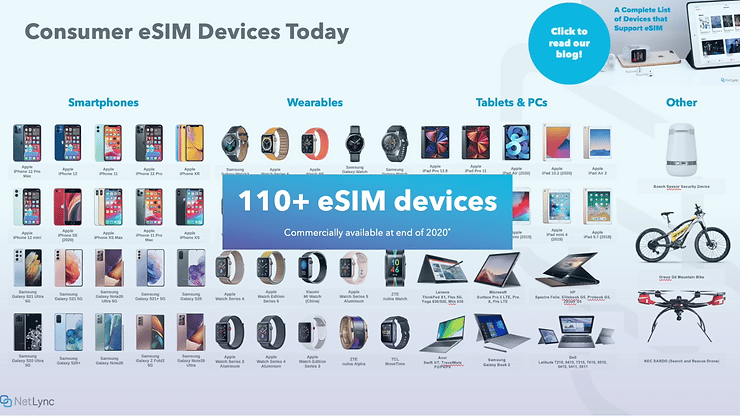
Here is a chart of many consumer eSIM devices available today. Across different device categories you can see that all the main device manufacturers support eSIM already, and many of those are supporting eSIM in their entire product range including smartphones, wearables, tablets, laptops and more.
Device Entitlements
Before we wrap up it's worth introducing the topic of device entitlements as these are becoming increasingly important for the management of eSIM-related services.
Let's start by looking at what device entitlements are.
Many mobile services today such as Voice-over-LTE and 5G are quite complex in nature, relying on a tight coupling of capability in the device and associated capability in the mobile network. A mobile device from a given manufacturer may well provide a number of compelling services, but only if those services are also supported by the mobile network the device is connected to at the time.
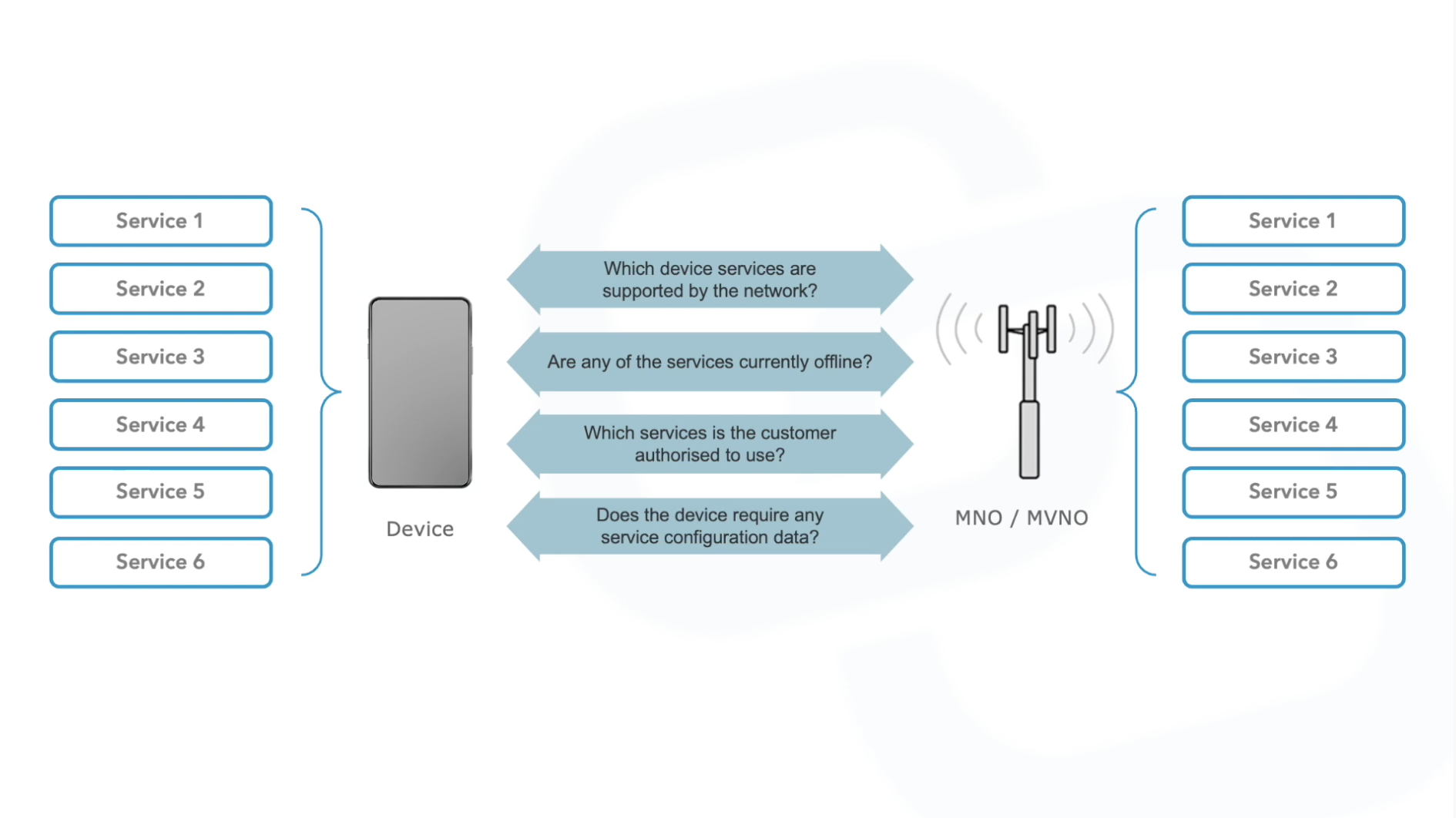
The device therefore needs a mechanism to determine a number of things including which of its own services are also supported by that particular mobile network, are any of those services currently offline for any reason, which services has the mobile network authorized the customer to use, and is there any specific configuration data required for any of those services to be loaded into the device.
For some services a dialogue with the customer via the device may also be required. For example to allow the customer to pay for and tailor those services, the mechanism chosen by device manufacturers to manage such services is called entitlements.
Each operator is required to hold their own Entitlement Server, but that server is built to the device manufacturer's specification. The mobile device is able to determine and connect to the appropriate Entitlement Server based on identity information stored in the SIM card, eSIM Profile, or in the device OS directly.
Once connected, the device can determine which of its own services are supported by the operator, which are currently operational, and whether the customer is allowed to use those services.
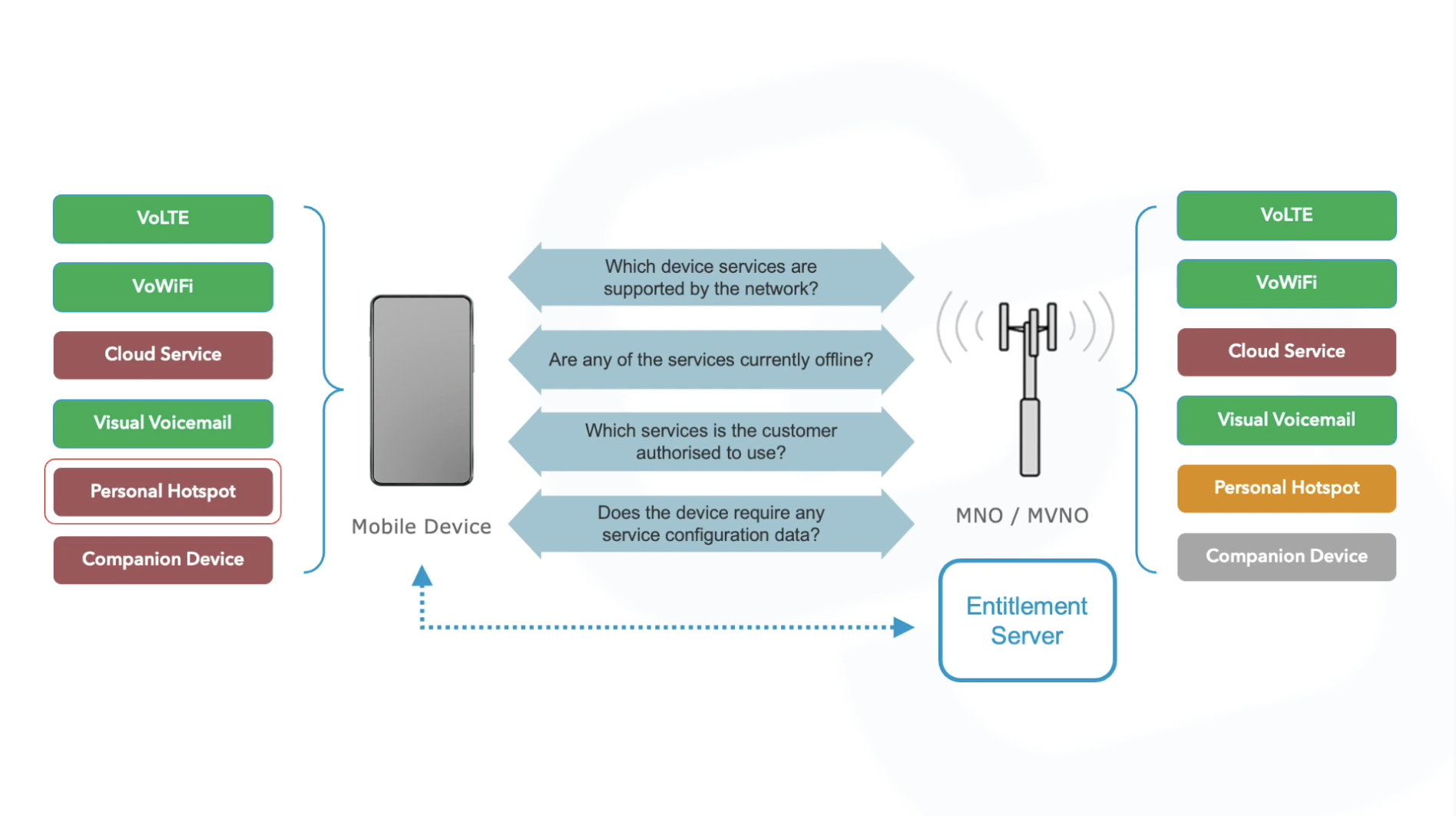
In the example here, Voice-over-LTE, Voice-over-WiFi, and Visual Voicemail are all supported by the network and currently operational, and so they are enabled in the device. Cloud service is supported by the network but is currently offline. Personal hotspot is also supported by the network but the customer is not yet authorized to use it and companion device is not supported by the network. This means, therefore, that cloud service, personal hotspot and companion device are all set to disabled in the device.
It may not surprise you then that entitlements is also useful for eSIM-related services. This started with the provisioning of companion devices such as smartwatches where the Entitlement Server would manage a web sheet-based dialogue with the customer on their smartphone in order to set up an eSIM subscription for the watch, then link that watch subscription with the customer smartphone, ensuring both devices ring when the customer receives a telephone call.
Over time further eSIM use cases have been added including setting up a subscription on a brand-new smartphone on the device itself straight out-of-the-box, and moving an eSIM subscription from one device to another, essentially replicating the process of moving a SIM card from one device to another, allowing the customer to easily upgrade their phone.
In summary then, Entitlement Servers are ideal for the management of a variety of mobile services ensuring operators support the latest, cutting-edge features in smartphones and other connected devices , all providing a great user experience for customers. And because of this we can expect to see entitlements becoming more and more prominent in the management of eSIM-related services.